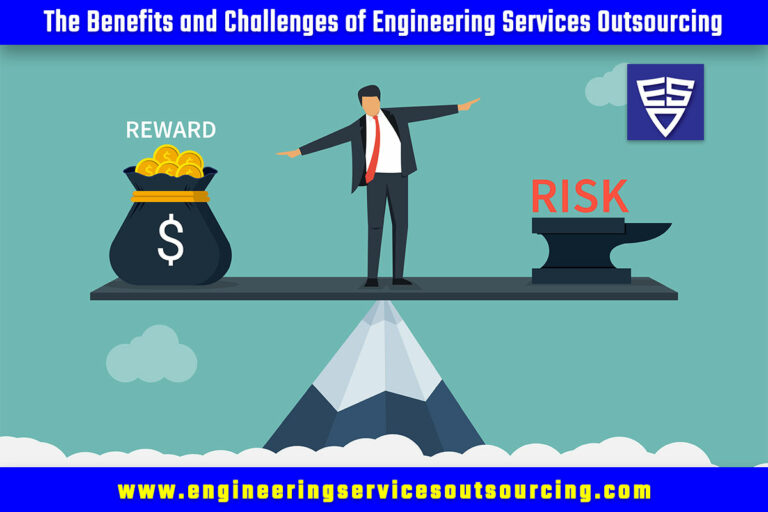
Engineering services outsourcing has become an increasingly popular option for companies looking to cut costs and improve efficiency. However, it’s important to remember that outsourcing is an investment, and like any investment, it should be evaluated for return on investment (ROI).
In this article, we’ll discuss how to evaluate the ROI of engineering services outsourcing, including the benefits and risks, key metrics to consider, and best practices for conducting an ROI analysis.
Table of Contents
Benefits of Engineering Services Outsourcing
The benefits of engineering services outsourcing are numerous, including cost savings, access to specialized expertise, and improved efficiency. Outsourcing can reduce labor costs by up to 60%, while also allowing companies to leverage the expertise of highly skilled engineers and technicians. Additionally, outsourcing can improve efficiency by allowing companies to focus on their core competencies and strategic initiatives, while leaving non-core tasks to external service providers.
Risks of Engineering Services Outsourcing
While the benefits of engineering services outsourcing are clear, there are also risks to consider. One of the biggest risks is the potential for a loss of control over the outsourced tasks. This can lead to a lack of transparency and accountability, as well as a loss of intellectual property. Additionally, outsourcing can lead to quality issues if the outsourced provider does not have the same quality standards as the company.
1) Key Metrics for Evaluating ROI
To evaluate the ROI of engineering services outsourcing, it’s important to consider a variety of key metrics. These include:
1.1) Cost savings:
This is the most obvious metric for evaluating ROI. Companies should compare the cost of outsourcing to the cost of performing the same tasks in-house. This should include both direct costs (such as salaries and benefits) and indirect costs (such as overhead and equipment).
1.2) Quality:
Quality should be evaluated both before and after outsourcing. Companies should establish clear quality standards and ensure that the outsourced provider is capable of meeting those standards. They should also conduct regular quality audits to ensure that those standards are being met.
1.3) Time-to-market:
Outsourcing can help companies speed up the development process by providing access to specialized expertise and resources. Companies should evaluate how outsourcing affects their time-to-market and whether it provides a competitive advantage.
1.4) Flexibility:
Outsourcing can provide companies with greater flexibility to scale up or down as needed. This can help companies respond to changes in market demand or other external factors.
1.5) Innovation:
Outsourcing can provide access to new ideas and technologies that can help drive innovation. Companies should evaluate whether outsourcing is helping them stay ahead of the competition and drive new product development.
2) Best Practices for Evaluating ROI
To effectively evaluate the ROI of engineering services outsourcing, companies should follow these best practices:
2.1) Establish clear goals and objectives:
Companies should establish clear goals and objectives for outsourcing before they begin the process. This will help them measure the success of outsourcing and ensure that it aligns with their overall business strategy.
2.2) Choose the right outsourcing partner:
The success of outsourcing depends heavily on the quality of the outsourcing partner. Companies should choose a partner with a proven track record of success and the expertise to meet their specific needs.
2.3) Conduct a thorough risk assessment:
Companies should conduct a thorough risk assessment before outsourcing to identify potential risks and develop a plan to mitigate them.
2.4) Communicate clearly and frequently:
Communication is key to successful outsourcing. Companies should establish clear lines of communication with the outsourcing partner and communicate frequently to ensure that everyone is on the same page.
2.5) Monitor performance:
Companies should regularly monitor the performance of the outsourcing partner to ensure that they are meeting quality standards, deadlines, and other requirements.
Once you have identified your goals for outsourcing engineering services and selected the right partner, it’s essential to measure the return on investment (ROI) of your outsourcing project. Evaluating the ROI of engineering services outsourcing helps you determine if the project is cost-effective and delivering the expected benefits. It’s important to note that calculating the ROI of outsourcing is more complex than calculating the ROI of an in-house project. However, by following a few best practices, you can accurately evaluate the ROI of your engineering services outsourcing project.
3) Key steps you can take to evaluate the ROI of engineering services outsourcing:
3.1) Define the scope of the outsourcing project:
Before you begin measuring the ROI of your engineering services outsourcing project, it’s important to define the scope of the project. This includes identifying the specific tasks or services you are outsourcing, the timeline of the project, and the budget allocated to the project. By having a clear understanding of the project’s scope, you can better track the progress of the project and calculate the ROI accurately.
3.2) Identify the costs of the outsourcing project:
The first step in calculating the ROI of engineering services outsourcing is identifying the costs associated with the project. These costs can include the fees paid to the outsourcing provider, travel expenses, and any other expenses associated with the project. It’s important to include all costs associated with the outsourcing project to accurately calculate the ROI.
3.3) Calculate the savings from the outsourcing project:
Once you have identified the costs associated with the outsourcing project, you can begin calculating the savings from the project. This can include savings from reduced labor costs, lower overhead costs, and reduced capital expenditures. You should also consider any indirect benefits of outsourcing, such as increased productivity, improved quality, and enhanced customer satisfaction.
3.4) Compare the costs and savings:
Once you have calculated the costs and savings associated with the outsourcing project, you can compare them to determine the ROI of the project. If the savings are greater than the costs, then the project has a positive ROI. If the costs are greater than the savings, then the project has a negative ROI.
3.5) Monitor the outsourcing project:
Monitoring the outsourcing project throughout its duration is essential to accurately calculate the ROI. By tracking the project’s progress and costs in real-time, you can identify any issues early and make adjustments as needed. This can help ensure that the project stays on track and delivers the expected ROI.

Conclusion:
In conclusion, evaluating the ROI of engineering services outsourcing is essential to determine if the project is delivering the expected benefits and is cost-effective. By following the best practices outlined above, you can accurately measure the ROI of your outsourcing project and make informed decisions about future outsourcing projects.
Related Article:






